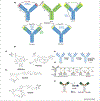Advances in antibody-drug conjugates: A new era of targeted cancer therapy
- PMID: 28627385
- PMCID: PMC6944323
- DOI: 10.1016/j.drudis.2017.05.011
Advances in antibody-drug conjugates: A new era of targeted cancer therapy
Abstract
Antibody-drug conjugates (ADCs), a potent class of anticancer therapeutics, comprise a high-affinity antibody (Ab) and cytotoxic payload coupled via a suitable linker for selective tumor cell killing. In the initial phase of their development, two ADCs, Mylotarg®, and Adcetris® were approved by the US Food and Drug Administration (FDA) for treating hematological cancer, but the real breakthrough came with the discovery of the breast cancer-targeting ADC, Kadcyla®. With advances in bioengineering, linker chemistry, and potent cytotoxic payload, ADC technology has become a more powerful tool for targeted cancer therapy. In addition, ADCs with improved safety using humanized Abs with a unified 'drug:antibody ratio' (DAR) have been achieved. Concomitantly, there has been a significant increase in the number of clinical trials with anticancer ADCs with high translation potential.
Copyright © 2017 Elsevier Ltd. All rights reserved.
Figures



References
-
- Scott AM et al. (2012) Antibody therapy of cancer. Nat. Rev. Cancer 12, 278–287 - PubMed
-
- Chabner B and Roberts TG (2005) Timeline: chemotherapy and the war on cancer. Nat. Rev. Cancer 5, 65–72 - PubMed
-
- Szakacs G et al. (2006) Targeting multidrug resistance in cancer. Nat. Rev. Drug Discov 5, 219–234 - PubMed
Publication types
MeSH terms
Substances
Grants and funding
LinkOut - more resources
Full Text Sources
Other Literature Sources
Medical

